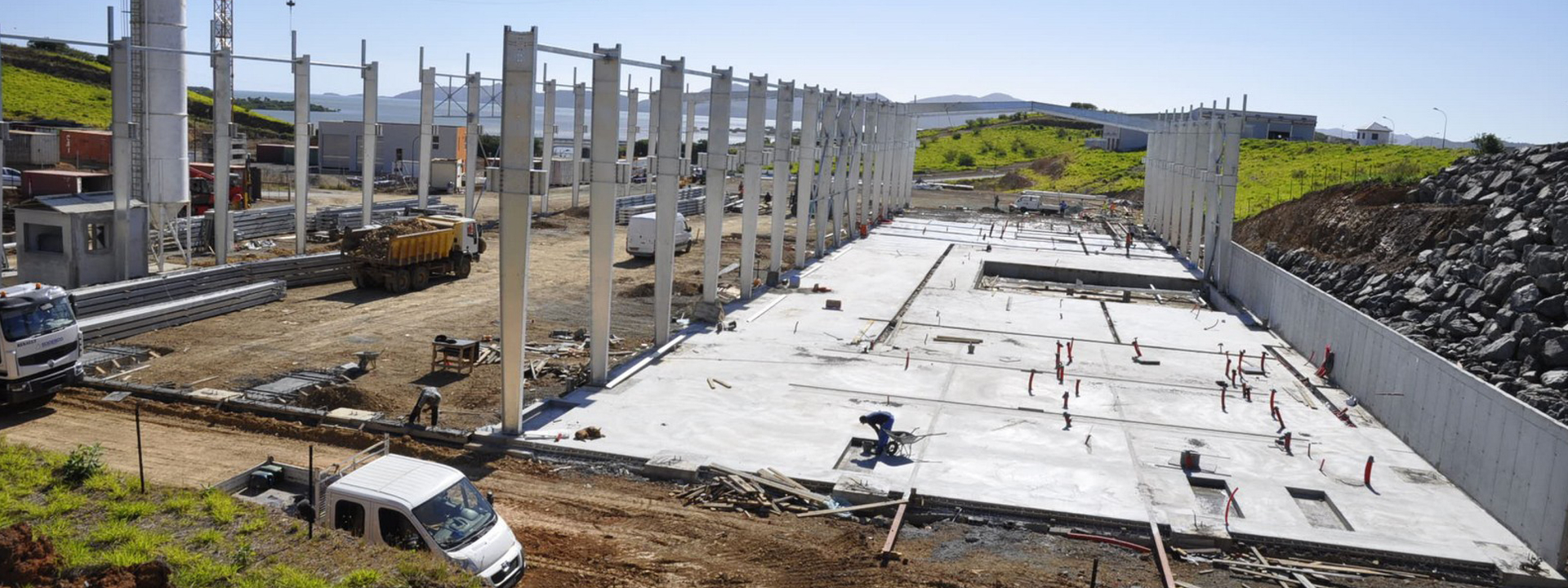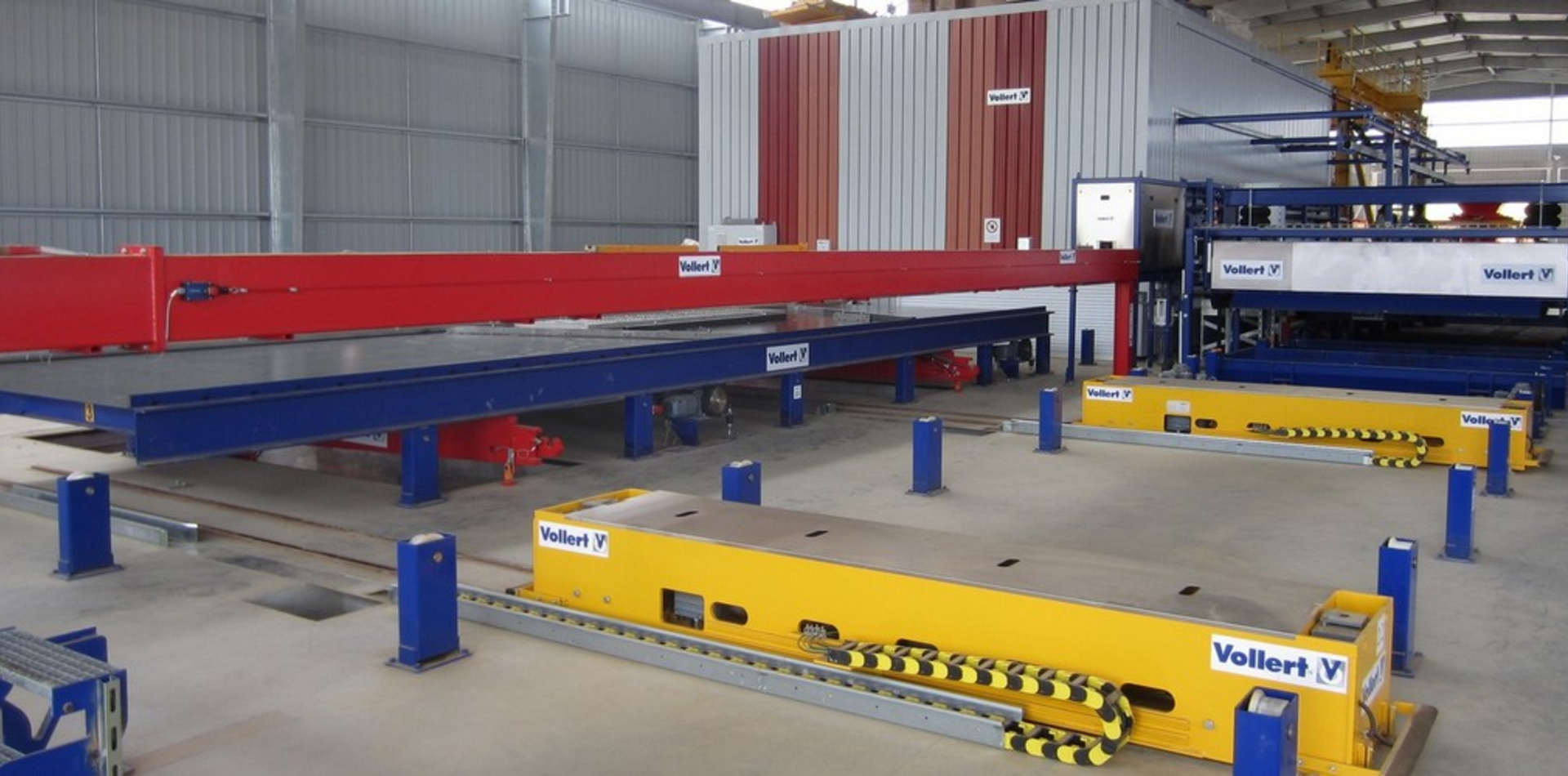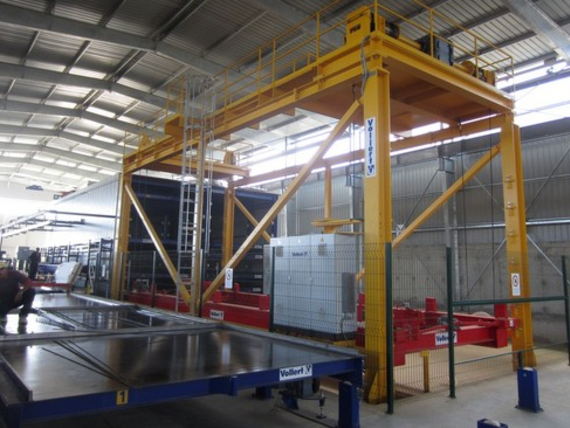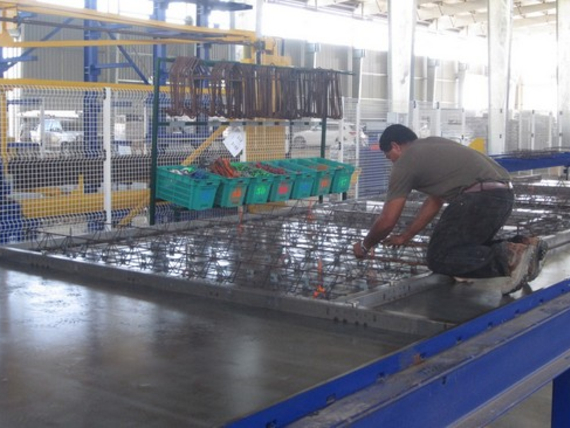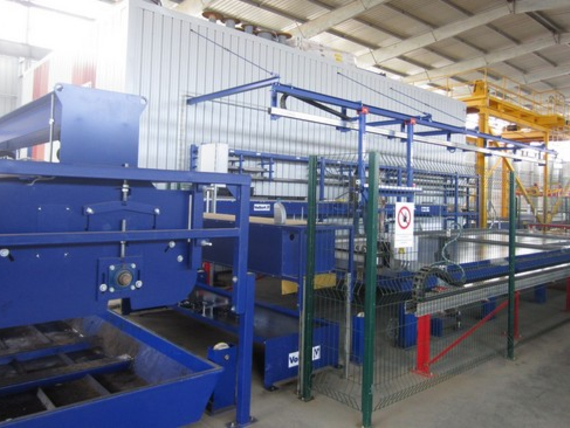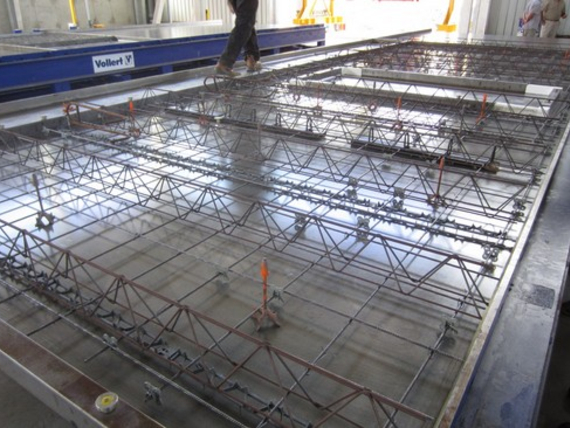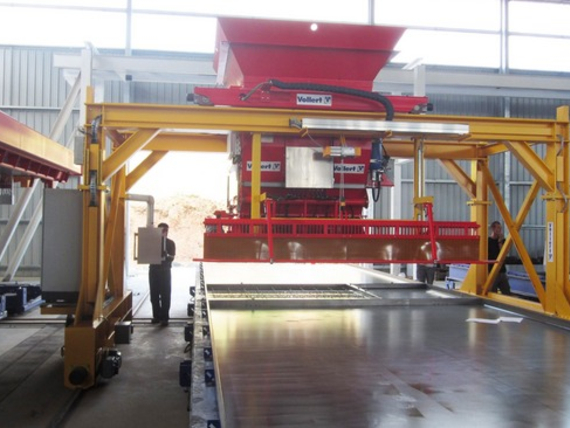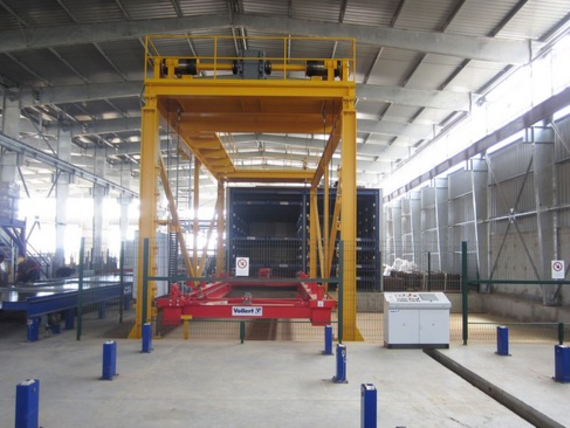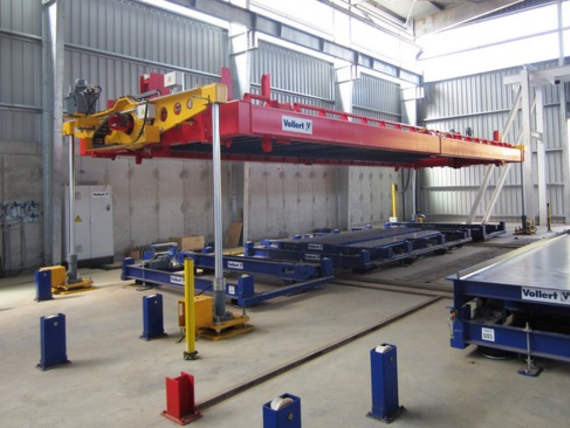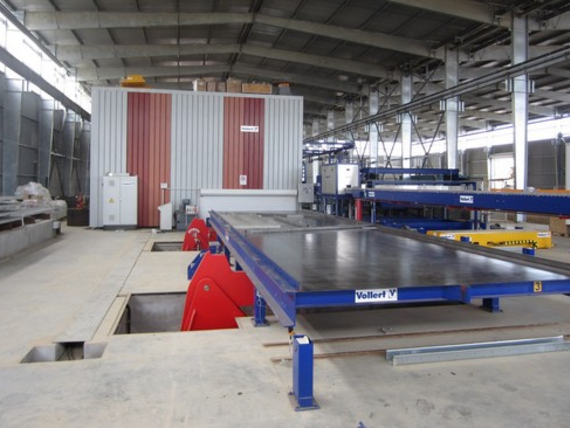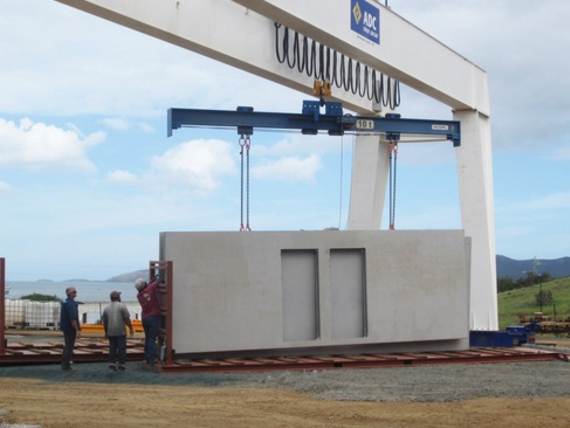The LBDP (Les Bétons du Pacifique) Group, predominantly a ready-mixed concrete supplier until now, selected the internationally operative planning office MC2 as its knowhow partner for this project. Vollert was chosen as the experienced plant partner and equipment supplier. As early as the design and planning phase, Vollert developed different scenarios and processes for this in close coordination with the customer using 3D simulations and calculation models. "The most profitable solution is always an individual one, depending on the precast elements to be produced, the required output quantity, the degree of automation and the investment sum", explains Philippe Marrié, the responsible sales engineer at Vollert. In order to be able to produce the desired variety of components consisting of laminar and structural precast elements, it was important above all to have flexible processes in order to be able to change over the production mix in the shortest possible time.
Modern plant and circulation technology provides for efficient processes
In the start phase there are constantly up to 15 formwork pallets in the semi-automated circulating system. The precast plant, which was completed at the beginning of 2014, will produce up to approx. 100,000 m² of untensioned floor slabs and double/sandwich walls annually. "For that we have used state-of-the-art plant technology as well as extremely robust, reliable machines that require particularly little maintenance - in the formwork preparation, in the concreting and turning procedures and also in the loading of the precast concrete elements. New Caledonia is 2,000 km from Australia and over 15,000 km from the European mainland, so that is very important", adds Philippe Marrié.
Solid and double walls up to 400 mm thick and floor slabs up to 60 mm thick are produced on a compact floor area of 1,600 m². A flexible pallet edge formwork attachment makes solid walls possible up to a wall thickness of 160 mm. Precast concrete element heights of up to 3.20 m are possible and a partially insulated design can also be realised. For smaller hall buildings, for example for storage areas, V-columns and beams can be manufactured on the same plant structure. "In addition we have developed a special formwork pallet for the manufacture of 18 untensioned U-girders. That was a technical challenge", explains Jürgen Schäfer, project manager at Vollert. At the centre: the circulation technology. Formwork pallets with a formwork area of up to 40 m² and area loads of up to 400 kg/m² move through each workstation in a self-contained circulation concept, controlled and monitored by sophisticated automation technology.
Preparation of the formwork surface is decisive for high quality standards
For the manufacture of high-quality precast concrete elements not only the concreting process and the following treatment of the surface are important; particular attention is paid to the preparatory work processes - above all to clean, technically perfect formwork profiles and optimum pallet preparation. First of all the formwork pallets are mechanically freed from adhering concrete residues by a rotary brush and a steel scraper unit. The cleaning process is initiated automatically as soon as a pallet moves into the cleaning zone. The speeds are adjustable. An electrically driven brush is pressed against the formwork profile to clean the fixed edge formwork. The formwork pallet is then sprayed evenly with release agent. Vollert uses particularly highquality rotary nozzles for this. The output of these nozzles can be individually tailored to the ambient temperature and viscosity of the release agent to ensure exceptional coverage while reducing consumption of the sprayed material.
In the next work process a CADCAM-controlled large plotter draws the outlines of the precast concrete elements to be produced 1:1 on the formwork surface. A watersoluble, easy-to-remove ink is used for this. In order to achieve the desired coverage accuracy of ± 1 mm, a pneumatically actuated pallet centring device is integrated. Dimensional errors are avoided and the processes are considerably rationalised by the automatic operation. This also ensures the high plotting speeds of 0 - 1 m/s.
Robust, reliable components additionally guarantee low downtimes. Once the centring has been released again, the pallet moves to the manual formwork positioning. Having arrived at the manual formwork station, a workplace system - a rack positioned alongside the pallet position with a catwalk at the height of the formwork pallet - serves to store formwork, magnets and built-in components. The formwork transport track has been integrated into the workplace system in order to facilitate the handling of the formwork. This allows ergonomic working in the formwork storage area. A mobile tool trolley holds the most important tools and aids required by the formwork fitter.
Reinforcing, concreting and compacting with state-of-the-art plant equipment
The reinforcement and the built-in components such as back boxes and transport anchors are fitted in the next work process. This takes place over several work stations. The reinforcement preparation takes place automatically; the data required for this is provided by the plant's master computer.
Today, modern concrete distributors ensure homogeneous and precise discharge of the concrete. Fed by a rotary bucket track, a rail-guided concrete distributor with a bridge design was chosen on account of the limited space available. This allows the discharge container, which has a maximum capacity of 3 m³, to drive not only longitudinally, but also transversely on the concrete distributor bridge and in this way to achieve a large discharge area of up to 3.20 m. The energy chain was sunk into the floor so that a fork-lift truck can drive over it. The concrete is discharged by means of a spiked roller/slide valve construction, manually controlled by means of a moving control panel attached to the side of the bridge. The discharge volume and the speed of the spiked roller (frequency controlled) can be optimally adjusted to different concrete consistencies. Hydraulically actuated flat slide valves block out the area in which no concrete is to be discharged, e.g. for windows. By means of the slide valve width adjustment, the width of the outlet can be optimally adapted to different kinds and consistencies of concrete (normal concrete, lightweight concrete, etc.). The roughening device provides for the timesaving roughening of the surface of the floor slab or the two concrete slabs of the double wall for a better connection with the cast-in-place concrete later on. A maintenance door facilitates the cleaning of the container interior of the spiked roller.
A compaction station ensures outstanding surface and edge quality. The concrete is compacted by a particularly quiet, low-frequency vibrating station. The vibrating movement is generated by an unbalance drive, thus compacting the concrete. Unlike a conventional compaction station, this enables the compaction energy to be precisely adjusted and stiffer concretes can also be processed.
Storage and curing
A floor-guided storage and retrieval machine (SRM), which is designed for a concrete area load of 400 kg/m², puts the pallets into storage and removes them again fully automatically. The hardening chamber consists of two lined rack towers, each with eight pallet shelves arranged one above the other. The pallets are driven in and out via friction wheels and a rack and pinion pusher. The SRM has adjusters for accurate horizontal positioning in the individual hardening chamber axes. Driving to the individual hardening chamber levels takes place by means of setting bars, whose set-down points are infinitely adjustable. A safety concept specially developed by Vollert prevents overloading of the lifting cable, thus minimising the risk of a cable breakage. The lifting system was designed optimally and the service life was extended by up to 5 years by appropriate dimensioning of pulleys, cable drums and cable.
After a hardening time of about eight hours, the cured floor slabs are moved out directly via the rack tower for demoulding. The floor slabs are taken up by the 16 lifting hooks of the lifting traverse and stacked horizontally in transportable piles in preparation for removal.
Double wall production with stationary pallet turning device
If a double wall is being manufactured, the SRM takes the pallet out of the hardening chamber after the hardening of the first shell and transfers it via the circulation to a stationary pallet turning device that. The hardened upper shell of the double wall to be produced is mechanically clamped to the pallet by clamping arms. For the subsequent turning procedure the turning frame is first lifted to a height of up to 2.3 m by hydraulically-actuated lifting cylinders. During the rotary movement the gravitational forces are absorbed by a longitudinal stop, which ensures a safe turning process and prevents the precast elements from slipping sideways. Manually adjustable spacer feet serve the production of different double wall thicknesses. As soon as the first shell has been turned by 180°, the lower shell drives under the turning device. This lowers itself and connects the two shells with each other: the double wall is created. Spacers in the precast concrete elements and the spacer feet on the turning device ensure that the desired thickness of the double wall is maintained. The double wall is subsequently compacted once again. To do this the fresh concrete of the lower shell is vibrated. This synchronous vibration without movement of the first shell relative to the second guarantees high product quality and no concrete segregation in the vicinity of the reinforcement. The clamping arms are subsequently released and removed. The upper, empty pallet is turned back. The pallet with the finished double wall now drives into the hardening chamber, the empty pallet is set down on the roller track and drives through the hardening chamber to the cleaning station.
Great value attached to removal and loading procedures
A large number of technical details ensure efficient processes where the removal and loading technology is concerned, too. In the lifting area the demoulded double wall is erected by means of a tilting station to an angle of 80° so that the double wall elements can be lifted off without damage using a hall crane. Once again, the cramped spatial conditions were considered here. The vertical erection of an empty formwork pallet returning from the pallet turning unit allows it to pass through. Hence, more time remains for lifting off the finished double walls, without lowering the productivity of the plant. Loading takes place safely using a lifting traverse which was installed by the concrete accessories specialist Nuspl. The traverse, which is fastened by means of a special stabilising device, picks up the finished double wall by its lifting anchors and loads it's onto the waiting setting frame. The precast concrete elements are removed exclusively by a run-off lifting carriage with a load capacity of up to 20 t, which connects the loading area with the outdoor storage area.
Following the demoulding of the precast concrete elements the formwork elements are placed on the formwork transporter, which transports them to the formwork cleaner. A feed unit specially developed by Vollert enables a higher feeding force during the transport of the formwork through the cleaner and thus a better cleaning force. Cleaning takes place conventionally with metallic circular and roller brushes. Subsequently the release agent is applied by nozzles in the release agent application unit before the formwork profiles are returned to the production circulation.
Centrally controlled, economically evaluated
The complete plant configuration as well as all storage and production processes are centrally controlled by a modern master computer system. A visualisation computer controls the individual work stations, creates the pallet occupation, routes the pallet transport and manages the order of removal from storage and the curing times. Evaluations constantly display statistics and production figures to the plant operator.
Conclusions
"This plant concept is characterised by state-of-the-art technology and an appropriate degree of automation", says Philippe Marrié from Vollert. "Above all, the flexible working processes put us in a position of being able to produce the most diverse precast concrete elements for houses, multi-storey residential buildings or hospitals and schools."

